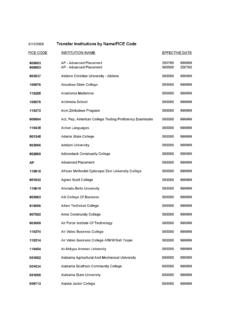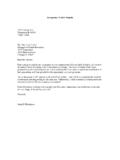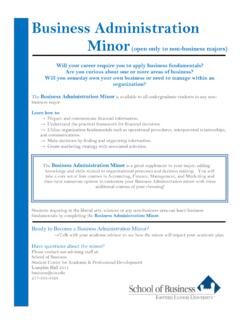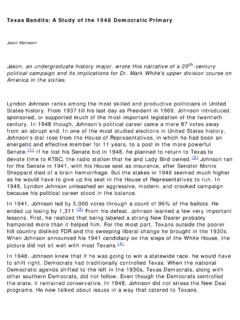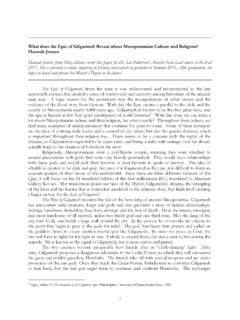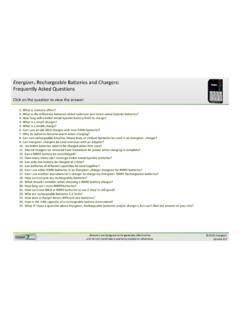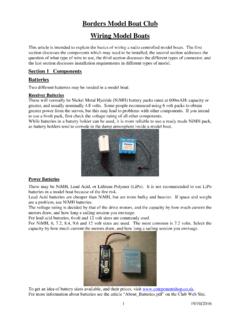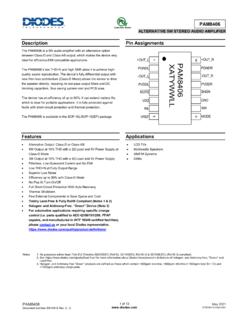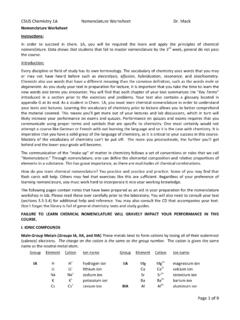Transcription of Tutorial 2 FORMULAS, PERCENTAGE COMPOSITION, AND …
1 T-6 Tutorial 2 FORMULAS, PERCENTAGE COMPOSITION, AND THE MOLEFORMULAS: A chemical formula shows the elemental composition of a substance: thechemical symbols show what elements are present and the numerical subscripts show howmany atoms of each element there are in a formula unit. Examples:NaCl: one sodium atom, one chlorine atom in a formula unitCaCl2: one calcium atom, two chlorine atoms in a formula unitMg3N2: three magnesium atoms, two nitrogen atoms in a formula unitThe presence of a metal in a chemical formula indicates an ionic compound, which is composedof positive ions (cations) and negative ions (anions). A formula with only nonmetals indicates amolecular compound (unless it is an ammonium, NH4+, compound). Only ionic compounds areconsidered in this are tables of common ions in your lecture text, p 56 (cations) and p 57 (anions). Acombined table of these same ions can be found on the inside back cover of the lecture text.
2 Asimilar list is on the next page; all formulas needed in this and subsequent Tutorial problems canbe written with ions from this formulas for ionic compounds is very straightforward: TOTAL POSITIVE CHARGESMUST BE THE SAME AS TOTAL NEGATIVE CHARGES. The formula must be neutral. Thepositive ion is written first in the formula and the name of the compound is the two ion : Write the formula for potassium name tells you there are potassium, K+, and chloride, Cl , ions. Each potassium ion is +1and each chloride ion is -1: one of each is needed, and the formula for potassium chloride isKCl. "1" is never written as a : Write the formula for magnesium contains magnesium, Mg2+, and hydroxide, OH , ions. Each magnesium ion is +2 andeach hydroxide ion is -1: two -1 ions are needed for one +2 ion, and the formula for magnesiumhydroxide is Mg(OH)2. The (OH)2 indicates there are two OH ions.
3 In a formula unit ofMg(OH)2, there are one magnesium ion and two hydroxide ions; or one magnesium, twooxygen, and two hydrogen atoms. The subscript multiplies everything in ( ).EXAMPLE: Write the formula for aluminum contains aluminum, Al3+, and sulfate, SO42 , ions. The lowest common multiple of 3 and 2is 6, so we will need six positive and six negative charges: two Al3+ and three SO42 ions, andthe formula for aluminum sulfate is Al2(SO4)3. Then, in a formula unit of Al2(SO4)3 there are twoaluminum ions and three sulfate ions; or two aluminum, three sulfur, and twelve oxygen POSITIVE IONSCOMMON NEGATIVE IONSCOMMON NEGATIVE IONSH+hydrogen[Fe(CN)6]3 ferricyanideC2H3O2 acetateNH4+ammonium[Fe(CN)6]4 ferrocyanideCN cyanideLi+lithiumPO43 phosphateCNO cyanateNa+sodiumHPO42 hydrogen phosphateSCN thiocyanateK+potassiumH2PO4 dihydrogen phosphateClO hypochloriteMg2+magnesiumCO32 carbonateClO3 chlorateCa2+calciumHCO3 hydrogen carbonateClO4 perchlorateSr2+strontiumSO32 sulfiteIO3 iodateBa2+bariumHSO3 hydrogen sulfiteMnO4 permanganateAl3+aluminumSO42 sulfateNO2 nitriteSn2+tin(II)HSO4 hydrogen sulfateNO3 nitrateSn4+tin(IV)S2O32 thiosulfateOH hydroxidePb2+lead(II)1 CrO42 chromateIO4 periodateBi3+bismuthCr2O72 dichromateH hydrideCr3+chromium(III)2O2 oxideF fluorideMn2+manganese(II)3O22 peroxideCl chlorideFe2+iron(II)S2 sulfideBr bromideFe3+iron(III)HS hydrogen sulfideI iodideCo2+cobalt(II)4Ni2+ nickel (II)
4 5Cu+copper(I)Cu2+copper(II)1 There is also a lead(IV)Ag+silver2 There is also a chromium(II)Zn2+zinc3 There is also a manganese(III)Cd2+cadmium4 There is also a cobalt(III)Hg22+mercury(I)5 There is also a nickel (III)Hg22+mercury(II)T-8 PERCENTAGE COMPOSITION: Imagine a class of 40 boys and 60 girls: 100 students total. 40/100 of the students are boys and 60/100 girls; or, 40% boys and 60% girls. The "%" signmeans percent, or parts per a class has 10 boys and 15 girls, for a total of 25 students. If you want to find out howmany boys there would be per 100 students, keeping the same ratio of boys to girls, thefollowing proportion can be set up: 10 boys X boys = 25 students 100 studentsThis means: "if there are 10 boys per 25 students, then there would be X boys per 100students." Solving this equation, 10 boysX = x 100 students = 40 boys25 students There would be 40 boys per 100 students, or 40% boys.
5 Percent calculation is based on thiskind of proportion. However, you do not have to set up the proportion each time you want tofind percent composition. Simply divide the number of parts you are interested in (number ofboys) by the total number of parts (number of students), and multiply by 100. This is exactlywhat we did to find X in the above THE PART BY THE WHOLE AND MULTIPLY BY 100 Suppose a mixture contains g salt, g sugar and g sand, for a total g ofmixture. The PERCENTAGE of each component in the mixture can be found by dividing the amountof each (PART) by the total amount (WHOLE) and multiplying by 100: g g x 100 = salt x 100 = sugar g g g x 100 = gThe sum of these percentages is 100%. Everything must total 100%.T-9 PERCENTAGE is written without units but the units are understood to be "parts of whatever per 100total parts.
6 " The "parts" and "whole" may be in any units as long as they are both in the sameunits. In the case of the above mixture, units could be put on the numbers and the percentagesthen used as conversion factors. For example, the salt could become g salt pounds mixture tons salt or or g mixture pounds salt tons mixtureEt cetera. We do not usually care about composition of salt/sugar/sand mixtures, but we docare about PERCENTAGE composition of pure chemical substances. Unless otherwise stated wealways mean percent by mass (weight).The formula mass of a substance is the sum of the atomic masses of all the atoms in theformula. For example, the formula mass of sodium chloride, NaCl, , is the sum of theatomic mass of sodium, , and the atomic mass of chlorine, The formula mass ofsodium sulfate, Na2SO4, is found as follows:2 Na: 2 x = g Na or lbs Na1 S: 1 x = g S or lbs S4 O: 4 x = g O or lbs O formula mass = g Na2SO4 lbs Na2SO4 Atomic mass and formula mass are in atomic mass units, but are usually written without units.
7 However, since these are relative masses of the atoms any mass unit can be used, as shownby the two columns to the right of the arrows, terms of atomic masses: in a total of parts by mass of sodium sulfate, parts aresodium, parts are sulfur, and parts are terms of a gram mass unit (molar mass): in a total of g of sodium sulfate, g aresodium, g are sulfur, and g are terms of pound mass unit: in a total of lbs of sodium sulfate, lbs are sodium, lbs are sulfur, and lbs are composition can be determined with the mass ratios from the formula mass: : x 100 = Na g Na or lbs Na Sulfur: x 100 = S g S or lbs S : x 100 = O g O or lbs O Total = g total lbs totalAs mentioned before, PERCENTAGE is written without any units but the units are understood to be"parts of whatever per 100 total parts".
8 Since these are relative masses any mass unit can beused, as shown by the two columns to the right of the arrows, terms of PERCENTAGE : in a total of parts by mass of sodium sulfate, parts aresodium, parts are sulfur, and parts are terms of a gram mass unit (molar mass): in a total of g of sodium sulfate, g aresodium, g are sulfur, and g are terms of a pound mass unit: in a total of lbs of sodium sulfate, lbs are sodium, lbs are sulfur, and lbs are the preceding calculations, the percent of each element in the substance was found. Thepercent of groups of elements may also be calculated. Suppose you want percent sulfate, SO42 , in sodium sulfate. The formula mass of sodium sulfate is and of that total + = is sulfate. Thus, : x 100 = SO42 : this is the sum of the percents sulfur and oxygen: S + 0 =.
9 We may say sodium sulfate is sodium, sulfur, and oxygen; or, and sulfate. The total is 100% in either now have two sets of numbers which show mass relationships among the elements insodium sulfate: (1) the formula mass and (2) the PERCENTAGE the formula mass on page T-9 various mass ratios, that is, conversion factors, may beobtained: g Na lbs Na2SO4 g S or or and others g Na2SO4 lbs S g NaFrom the percentages on page T-10 various mass ratios may also be obtained: g Na lbs Na2SO4 g S or or and others g Na2SO4 lbs S g NaWe can now solve problems like the following:EXAMPLE: What mass of sulfur is contained in g of sodium sulfate?
10 Use formula mass ratios on page T-9 for the appropriate conversion factor: g g Na2SO4 x = g S g Na2SO4OR, use PERCENTAGE composition ratios on page T-10: g g Na2SO4 x = g S g Na2SO4T-12 EXAMPLE: What mass of sodium is combined with g of sulfur in sodium sulfate?You may use a conversion factor from the formula masses OR PERCENTAGE composition: g g S x = g Na g S OR g g S x = g Na g S Obviously, you do not have to calculate percent composition every time you do a problem likethis: use formula mass ratios; if the PERCENTAGE composition is given, then use MOLE: The most important concept you encounter this semester in Chemistry is the mole. The mole may be defined:The mole is the amount (mass) of a substance which contains the same numberof units (atoms, molecules, ions) as there are atoms in exactly 12 mass units ofthe carbon-12, 12C, does not matter what mass units are used as long as the same mass units are used for thesubstance and the carbon-12.
